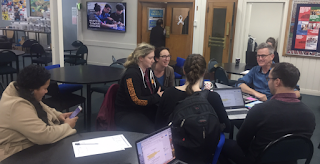My Big Picture plan
I started with a big picture plan and I was guided by two questions:
1. How can I help/support/guide the most number of people to make the most impact in addressing this issue?
2. What do I need to do/fix/start within our school that would support the implementation of effective writing?
From this plan, I focused on a number of areas that I wanted to engage with and implement as part of my 'Big picture plan' and throughout this year, I have developed these programmes with the support of our school and Manaiakalani, who have allowed me the time to get these initiatives up and running.
I want to share with you my reflections on a few of the things that I felt were the most successful. I have tried to write briefly what I did and what the outcomes were below.
The Students
- Designing engaging contexts
The TKI e-asttle 'Assessment for Learning' site describes ways to communicate the value of knowing about asttle to educators and explains the importance of sitting down with students to inform them of where they are at with their results and how to set goals to raise their achievement. I recently wrote two blog posts about a writing plan that I'd developed to support our juniors in their recent exams (Year 9 post and a year 10 post). Both blog posts gained some positive comments from educators in and around our outreach clusters, to schools such as Hornby Primary and I was excited to hear that their leadership team were going to try aspects of the my writing plan in their school.
 |
| Top tips for kids writing |
- My Classroom Inquiry
 |
| A few of my year 12's on our recent visit to the 'Are we there yet' exhibition. |
- Our Social Science Department literacy goals
 |
| The bestest department ever- Social Sciences team |
- Our Write that Essay (W.T.E) team
 |
| Our W.T.E team in action |
- PLD opportunities for our teachers
 |
| Lenva in her element - sharing her knowledge at the Tamaki College Staff PLD |
- Connecting with our Primary school teachers
One of the real benefits of being an across school COL teacher was that I got to meet with some really hard-working practitioners who generously gave me their time to share their knowledge. At Glenbrae Primary, Elfrida Raj invited me to a number of their PLD sessions to see how they were incorporating writing in their PLD as a school wide goal and I was excited to be part of the planning with my insights into what we have found was needed at the college. At Point England Primary, Rob Wiseman shared his writing strategies and units that we could link up with to connect common contexts. At Tamaki Primary, Heather Collins discussed ways that we could be 'seen' and be actively involved more at their school and Prem Rankolowan invited me to meet some of our potential year 9 students who will be coming to the college next year and next week, Robyn Anderson from Panmure Bridge will be bringing some of her talented students to teach some of our kids how to use google drawing better. These examples of the openness of staff in our cluster to share their practice, supports the theory that if we can build a relationship based on trust and respect, we can move towards being united in our teaching and learning journeys, whilst still embracing our uniqueness. I look forward to working more proactively with our primary teachers in the future.
 |
| A writing wall at Glenbrae. |
- Connecting with teachers across the globe
Earlier this year, I had the privilege of meeting Wayne Poncia, the Chief Product Officer of Hapara who invited us to be part of a Global Colab project involving students from Tamaki College, Canada and the States collaborating on solving a global issue. As part of the planning team, we have met online several times and have designed a programme that will use workspace for teaching and learning. This project kicks off in term 1 of 2019, and we are really excited to be part of it.
 |
| Wayne Poncia on the right, who has kindly blocked me out:) |
My personal learnings
There is no guidebook or instruction manual on how to be an effective across school COL teacher. I think back to where I've come from and yes, I have done some good things and started some cool initiatives but at the end of the day, will it help our kids improve their writing? It's hard to say at the moment, as you can't put your finger on just one thing that might work but I hope that part of my plan has helped start a movement.
There were days when I wasn't sure that I was doing the right thing or working hard enough and I felt like giving up. But I had to remember to keep my eyes on the prize - helping our kids. At the end of this journey of inquiry, I have recognised a determination in me that has grown out of what drives us teachers to work as hard as we do. It had given me purpose and reaffirmed that our kids are at the centre of all we do.
Kia kaha, kia toa, kia manawanui.





No comments:
Post a Comment